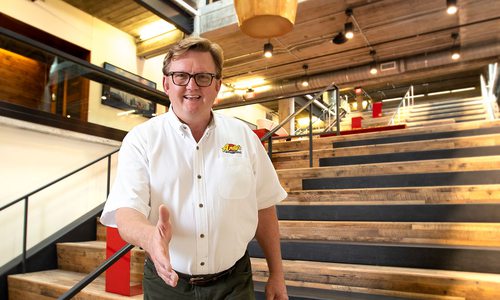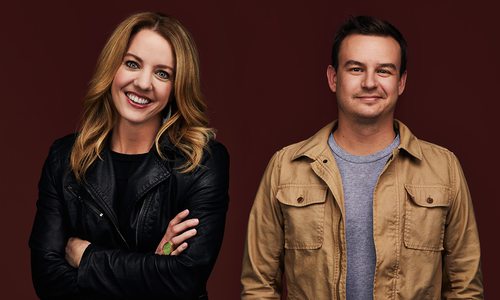When A Beautiful Mess co-owner Emma Chapman and her husband, Trey George, wanted to expand their online brand into a bar, they reached out to friend and owner of Scotch & Soda Joshua Widner. Together with designer Rogan Howitt, they’re combining their branding knowledge and bringing a southern Havana-style rum bar to downtown Springfield.
Biz 417: What are some of the lessons you’ve learned from your individual businesses that are helping you with The Golden Girl?
Emma Chapman: One of the biggest lessons I learned the hard way at A Beautiful Mess is you should always let people who are better at something than you do it. I think that’s why Josh and Rogan were such attractive partners to us, because they clearly know how to do this.
Joshua Widner: The thing that I’ve learned is patience. You can ask anyone that worked with me. I wasn’t the easiest person to work for the first year and a half [at Scotch & Soda], but now I don’t care about anything. Everything just happens. Patience with timelines and contractors, nothing was as big of a deal now as it seemed to be three years ago to me. Patience with people and employees, that’s what I’ve taken away from my previous years of owning and operating a bar, that and all the hurdles that you didn’t see coming. I know those, and I know not to repeat mistakes.
BIZ: How does The Golden Girl brand differ from A Beautiful Mess and Scotch & Soda branding?
EC: With A Beautiful Mess, the branding is for women. Although I think women will definitely enjoy the bar, it’s not a bar just for women. I think that’s where the ABM branding stops and the collaboration really starts. This is not for this demographic; it’s for the Springfield downtown demographic.
JW: The Scotch & Soda branding is really masculine and almost the exact opposite. I hadn’t thought about it like that, the yin and yang of what we do. We as two different companies pull entirely different demographics, so hopefully with this one we can bring everybody in.
BIZ: How are you approaching this business differently than your other businesses?
JW: There’s not a substantial rum portfolio downtown or anywhere in the city. We’re going to try to get as much rum as we can possibly get our hands on because selection is everything. An emphasis on rum by itself—quality rums, neat or on the rocks—is also huge for our menu. Flights of different spirits and different rums are going to be as big if not bigger than cocktails as well. Tiki cocktails are extremely labor-intensive and very time-consuming, and if you’ve been to a tiki place in another city, you know it takes 20 minutes to get a 15-ingredient zombie because that’s just literally what it takes. Dispensing a fresh zombie in seven seconds instead of waiting 10 to 15 minutes is huge.
EC: You’ve really emphasized a lot of fresh food, which I like a lot.
Rogan Howitt: There are so many people out there who are trying to be health conscious, especially if it’s a quick lunch. It’s hard to do. I think that alone will be the draw for people that want to go out and have something healthy for them. It’s hard to eat light. The menu hasn’t been finalized yet, but there’s a huge vegetarian emphasis on our menu.
BIZ: What are each of your roles in The Golden Girl development?
R.H.: I’ve done the logo. I’m going to be doing all the paper branding stuff basically, then we’re all going to be designing the bar together. Then when it starts up, I’m going to be the one to run the place.
J.W.: Mine’s more clerical with this project and not as exciting as it can be. Cocktail design, cocktail implementation, interior design, and then there’s all the crap that’s no fun like paying the taxes and the payroll, the serious stuff.
E.C.: Trey and I are going to be more focused on marketing. He’s working on building their website right now. I’m really excited to photograph all of our offerings for the website because I love food photography, and everything is sounding so pretty and so interesting and colorful because of the fresh aspect. Other than that, I’m going to get out of these guys’ way. They really know how to run a good bar.
J.W.: I think we’re both excited to learn from each other, too. I’m not the best when it comes to social media and marketing at all, but they’re amazing at it. I think they’d like to sit around and watch us do what we do. We really are a team.
BIZ: Describe the evolution of your plan. What has changed?
J.W.: The naming was probably the hardest part. It took us months to figure out something that was not kitschy. There’s so many puns you can do with rum drinks and sailing and all the things associated with the rum lifestyle. Naming was a big hurdle. As far as the plan for cocktail design, implementation and everything back of house hasn’t really changed. It’s kind of the exact same project that I was pitching. It’s more or less a southern Havana-style rum bar. A lot of people in my field are doing tiki places right now, which are a lot of fun, and I love them. That kind of branding only allows for so much. I think we wanted to have a broader scale of what we can do with rum, and we didn’t want to just focus on tiki. I won’t call it a fad, but tiki is big right now, and I think it will be for a long time, but this bar should feel timeless. It should stand the test of time as far as the design is concerned.
BIZ: How will your menu stand out?
J.W.: The menu is exciting because it reads beautifully and looks like an amazingly constructed menu, then you realize that over half of it is vegetarian.
E.C.: You don’t even realize until you’re digging in there. This seems like it has a lot of comfort to it, but there’s actually a lot of really fresh options and vegetarian options, and that’s when you know a place has done it right. I’ve been really impressed by that.
J.W.: The cultures that cultivate and distill rum and the rum cultures behind all the islands, they have a lot of fun stuff that we’re going to get to do like roasting whole goats and roasting whole pigs. This is not a kale and vegetarian restaurant by any means. That culture lends itself to doing some fun large animal feasts, and we’re into that.
E.C.: We’re in a great part of the country to be doing stuff like that because there are so many farmers around here.
J.W.: Everything we do is going to be as close to the source as we can possibly get it and using as many local people as we can. My chef that we’re still working out the kinks with is extremely passionate about sourcing everything locally and as fresh as possible and as cleanly as possible.
BIZ: What are you most looking forward to about opening downtown?
E.C.: We really want it to be a destination spot for a nice dinner and also lunch because I think being downtown, although I think it had its hurdles acquiring the property and being in that area, there’s definitely a need for both of those things. I go downtown for a quick lunch because our offices are near there, but I also go downtown for a date night. We’re looking to do something that can cater to both of those things.
J.W.: Absolutely. With all the new developments downtown, the live-in population is going to grow so much that it will really necessitate some more lunch options.












